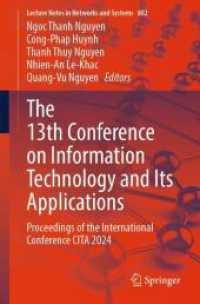- ホーム
- > 洋書
- > 英文書
- > Science / Mathematics
基本説明
Based on the author's research conducted through their development of a program in Sao Paulo Brazil, the book explores the history of toxic chemical release reporting programs, presents data on the actual toxicity of chemicals currently in use.
Full Description
Catastrophic events such as the Bhopal, India tragedy and rising incidences of cancer in areas neighboring industrial facilities have heightened concern over the use of toxic chemicals in manufacturing and industry, particularly with respect to long-term exposure. While legislation and publicity have reduced the use of some chemicals, risks remain that continue to threaten the health of individuals worldwide. Based on the authors' research conducted through their development of a program in Sao Paulo, Brazil, Toxic Chemicals: Risk Prevention Through Use Reduction examines various toxicity factors and proposes a plan to reduce the toxic impact of these hazardous substances.
Explores all factors that contribute to toxicity
The book begins by exploring the history of toxic chemical release reporting programs, a trend growing out of the Bhopal tragedy. It surveys their impact both in the United States through the Toxics Release Inventory (TRI) program and in the 29 other countries that maintain similar programs. Then, with the goal of developing a rational method of prioritizing toxic chemicals for reduction, the authors discuss mobility, persistence, and bioconcentration adjustment factors and present a method for integrating all of these factors to estimate the relative impact of chemical release.
Compares alternate emphases in existing programs
The book describes programs that concentrate on reducing the release of chemicals with the greatest adverse toxic impact and those that require companies to prepare pollution prevention plans and set goals for reducing use or release. It also examines technical assistance programs that help companies search for alternative chemicals to use or process changes that eliminate the use of toxic chemicals. In addition, it explores alternative market-based approaches for achieving environmental protection.
Presents a workable plan for the future
In the final chapters, the authors lay out their proposed program for reducing the use of toxic chemicals. This plan builds on the existing TRI program and uses lessons learned from this and other programs. The combined research assembled by the authors and their multifaceted approach to the issue of chemical toxicity enables companies and policy makers to move to the next level of toxic chemical use reduction, resulting in a safer environment for future generations.
Contents
Introduction. Toxic Chemical Composition Reporting. Toxic Chemical Release Reporting. TRI Programs in Other Countries. TRI Program Impacts on Reducing Toxic Chemical Releases. Quantifying Toxicity. Quantifying Mobility. Quantifying Persistence. Quantifying Bioconcentration. Developing Effective Toxicity Factors. Focusing on Impact Chemicals. Use versus Release Reporting. Pollution Prevention Planning. Technical Assistance. Market-Based Approaches to Environmental Protection. A Program to Reduce Toxic Chemical Use. Costs and Benefits. Appendix A: Chemicals List with CAS Numbers. Appendix B: CAS Numbers with Chemical Names.








